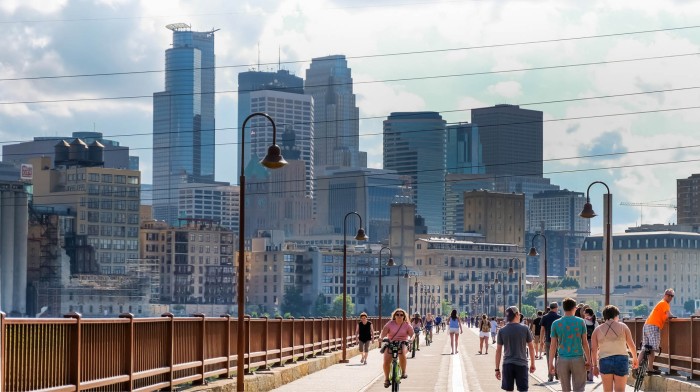
It’s only halfway through summer, and Minnesota has been feeling the heat. At the end of June, the Twin Cities hit 101 degrees, making it the hottest temperature in the area since 2012, according to the Minnesota Department of Natural Resources. On top of that, on average, Minnesota has only 13 days each summer with temperatures over 90 degrees, and so far we’ve had 11.
Summer doesn’t just feel like it is getting hotter, either; it is getting hotter, according to Vishnu Laalitha Surapaneni, MD, MPH, a M Physicians internal medicine physician who educates patients and other physicians on how to protect themselves from health impacts of climate change.
“The 2010s was the hottest decade on record,” she explains, “We are definitely seeing the health impacts from these extreme temperatures.”
Extreme heat and health
When it comes to how extreme heat affects health, Dr. Surapaneni says it’s important to know that, for Minnesota, it’s not just the summer heat, but the spring heat in May and June that has an impact.
“In Minnesota, during the winter, our bodies lose their ability to deal with heat. Spring is supposed to let our bodies acclimatize to higher temperatures. When we have days with temperatures over 90 like we did this May, we are more likely to see heat-related illness.”
In Minnesota and other Midwestern states, the heat index threshold is 86 degrees, “which is when we see more hospitalizations for heat-related illnesses,” Dr. Surapeneni says, noting that, “For those in northern Minnesota, where it is generally cooler and homes may not have air conditioning, finding respite from extreme heat can become additionally challenging.”
Prolonged exposure to extreme heat can lead to a variety of conditions like heat cramps, dehydration, heat exhaustion and heat stroke, which can be fatal. “We define extreme heat as three to five hot days and nights with high temperatures, hotter than average for the region, and no respite,” Dr. Surapaneni notes.
Heat exhaustion and heat stroke are among the most serious heat-related conditions, according to the Centers for Disease Control and Prevention (CDC). Heat exhaustion symptoms often include:
- Headache
- Muscle cramping
- Fatigue
- Nausea or vomiting
- Fainting and dizziness
“Heat stroke is an emergency and is fatal if not treated promptly,” Dr. Surapaneni says, which includes symptoms like:
- Body temperature higher than 103 degrees
- Red, hot and dry skin, with no sweating
- A rapid heart rate
- A painful headache
- Confusion
- Fainting
“This is why we all need to be heat aware,” she says. “Someone suffering a heat stroke might not be able to call for help themselves. It’s important to make sure friends and loved ones are protected from heat.”
Warm, stagnant air can also lead to worsening respiratory conditions, according to Dr. Surapaneni. When hot air stagnates in one place, pollutants in the air begin to interact with each other, generating ground-level ozone which can lead to asthma attacks for sensitive groups.
Who is most at risk for heat-related illnesses?
High-risk groups include those who work outdoors, like construction workers, farm workers, delivery drivers and mail carriers, Dr. Surapaneni says.
Older adults and those who live without air conditioning are also at risk, Dr. Surapaneni explains, especially those who take medications for high blood pressure, mental health conditions or heart failure, which can make it harder for the body to acclimate to heat.
Urban and rural areas see different kinds of risk, too. In urban areas, the urban heat island effect can lead to temperatures that are 22 degrees warmer than in surrounding areas. Whereas those in rural areas, usually in historically colder regions like Northern Minnesota, are less likely to have in-home air conditioning, which makes it more difficult for people to get respite during heat waves.
How to protect yourself and others from extreme heat
When hot days and nights are on the horizon, Dr. Surapaneni recommends keeping in mind these tips to help stave off the worst of extreme heat:
- Minimize your exposure to the heat, if possible.
- Be proactive in checking on loved ones during heat waves and make sure they’re okay.
- Stay hydrated. When working in the heat, the CDC recommends drinking 8 ounces of water every 15-20 minutes.
- Take advantage of local cooling centers like public libraries, which offer spaces to cool off and enjoy a good book (library cards are free! Find one here).
- If you experience symptoms of heat exhaustion or heat stroke, seek medical care immediately.
Dr. Surapaneni notes, however, that not everyone can take advantage of these measures. She cautions that these are individual-led solutions for systemic problems. That means those most vulnerable fall through the cracks.
For example, outdoor workers cannot just take the summer off. Low-income families are often forced to choose between paying for air conditioning or paying for groceries, and those experiencing homelessness are particularly high-risk.
“It is essential to have systems-level interventions to protect our communities from extreme heat” she says. These could include:
- An extreme heat plan for schools and summer camps
- A neighborhood watch program for the elderly during heatwaves
- Public policies like workplace regulation for workers and building accessible community cooling centers will benefit public health
Long-term, Dr. Surapaneni says systemic interventions like moving to solar or wind energy and creating more green spaces in urban areas can help too.
“We’ve got to prepare ourselves to endure more heat,” she notes, “And we have to do more as a community to address the effects of climate change. Our health depends on it.”